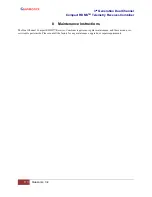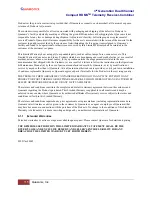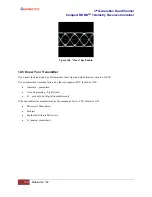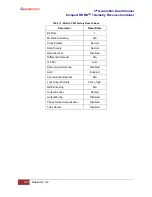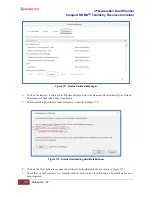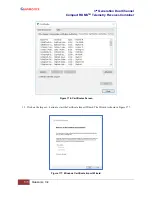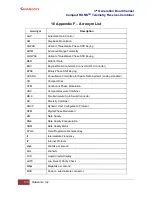
3
rd
Generation Dual Channel
Compact RDMS
TM
Telemetry Receiver-Combiner
124
Quasonix, Inc.
The PCM Framer uses serial streaming data, either from an external source or an internal pattern generator, to fill
the data portion of the frame. There is no mechanism to align specific sets of serial bits to Data words, and there is
no mechanism to align specific data words to a given position within the frame format. Therefore, the PCM Framer
cannot generate frames with data parameters suitable for decommutation. It can, however, be used to test frame
synchronization and link quality via SFID verification. Further, if the serial streaming data is a known pattern, the
data can be monitored by a BERT at the receiving end after data extraction.
13.2 PCM Deframer
The PCM Deframer supports
fixed-length
PCM frame recognition with the following parameters:
•
Major frame length up to 256 minor frames
•
Minor frame length up to 16,384 bits
•
Minor frame sync pattern 16 to 33 bits (user-selectable pattern and length)
•
Optional subframe ID (SFID) checking (word 1 position only)
Acquisition of PCM frame lock takes place according to the process recommended by RCC 119 Section 4.6. There
are four settable parameters that are used to configure acquisition and re-acquisition:
•
CORR_APERTURE – Number of bits, early or late, that the sync pattern may appear relative to other
detected sync patterns and still be detected
•
CORR_THRESH – Number of bits of the sync pattern that must match to declare sync detect
•
LOCK_THRESH – Number of valid sync detects required to declare PCM frame lock
•
SEARCH_THRESH – Number of invalid sync detects required to declare loss of PCM frame lock (once
locked)
The PCM Deframer acquires frame lock using the following states:
•
Search – Detect sync pattern if correlation of any set of bits exceeds CORR_THRESH
•
Check – Declare PCM frame lock if valid sync pattern appears LOCK_THRESH consecutive times
•
Lock – Maintain PCM frame lock until invalid sync pattern appears SEARCH_THRESH consecutive times
SFID checking occurs whenever PCM frame lock is detected. The SFID is expected to be located in the first word
after the sync pattern, as shown in Figure 169, and it is considered valid if it is one greater than the previous SFID,
or if it is 1 and the previous SFID was Z (the major frame length).
The PCM Deframer cannot be programmed to perform decommutation. It can, however, optionally strip the sync
pattern and SFID (if present) to leave only the frame data. If the fame data is a known pattern, it can be monitored
by a BERT to measure link performance.
The RDMS™ receiver can output PCM frame lock and/or SFID valid indications on the DEMOD_LOCK and/or
ONES_DETECT back-panel outputs. Refer to the RDMS™ data sheet for more information about these outputs.




